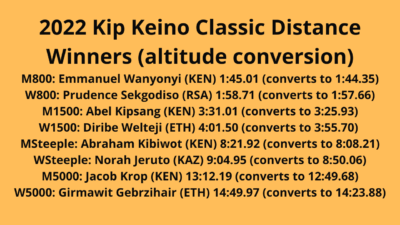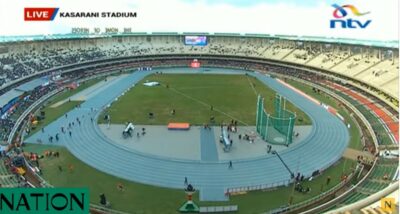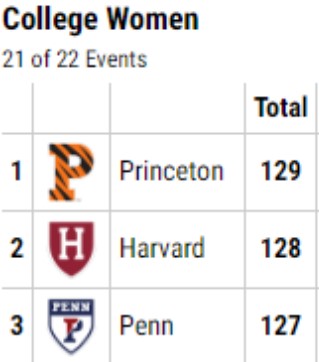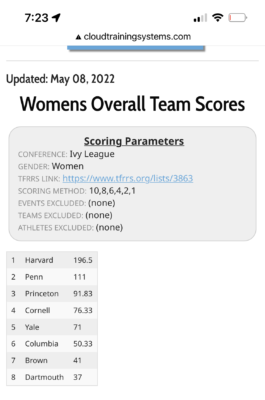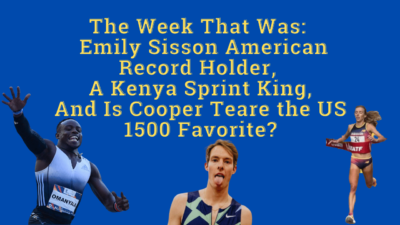WTW: Emily Sisson gets the AR, Kenya’s Ferdinand Omanyala rules the sprint world & is Cooper Teare the US 1500 favorite?
The Week That Was in Running, May 2 – 8, 2022
By LetsRun.com
May 9, 2022
Each week, we try to make the sport more fun to follow by putting the prior week’s action in perspective for you. Past editions of our Week That Was weekly recap can be found here. Got a tip, question or comment? Please call us at 844-LETSRUN (538-7786), email us, or post in our forum.
***
Emily Sisson runs 67:11 to break American record at US Half Marathon Championships
The US Half Marathon Championships were held on Saturday in Indianapolis, and the men’s and women’s races could not have been more different. The men’s race was a four-man battle over the final miles between Leonard Korir, Futsum Zienasellassie, Jacob Thomson, and Reid Buchanan before Korir and Zienasellassie separated on the long final straightaway. Korir ultimately outlasted Zienasellassie, who went to high school in Indiana, to win the title by one second in 62:35. It was Korir’s third US Half title (he also won in 2017 and 2019).
The bigger story came in the women’s race. Emily Sisson, the US 10,000m champion, has long targeted the American half marathon record and has come agonizingly close to breaking it in the past. In Houston in 2019, Sisson ran 67:30 to miss the record by five seconds. In Valencia the next year, she ran 67:26 to miss it by one second. Earlier this year, Sara Hall lowered the record from 67:25 to 67:15, and that was the mark Sisson was targeting on Saturday.
By 5k (15:54), Sisson had dropped the rest of the women’s field, but her next three 5k splits were 16:03, 15:57, and 15:58 – all slower than record pace of 15:56. By the time she hit 20k in 63:52 (67:22 pace), it looked as if her attempt would end in another near-miss. But Sisson summoned a kick and ran her final 1097.5 meters in 3:19 (63:45 pace, 4:51.8 mile pace) to finish in 67:11 (5:07.5 mile pace).
View this post on Instagram
A few thoughts on Sisson, the record, and the race in Indianapolis.
Sisson’s perseverance over the last two years has been impressive
Sisson was one of the favorites to make the team at the 2020 Olympic Marathon Trials but the Atlanta course got the best of her and she wound up dropping out. She then rebounded to make the Olympic team in the 10k with a dominant performance at the Trials last June, but was injured ahead of the Olympics (she still finished 10th) and ultimately had to withdraw from the NYC Marathon last fall. She returned with a win at the US 15K champs in March but then got COVID at the end of March and had a less-than-ideal buildup ahead of this race. Sisson said on the broadcast after the race that her plan is to stay on the roads this summer – so no US 10,000 champs at Pre on May 27 – before running a fall marathon.
This record can still go a lot faster
After Hall broke the AR in January, one of our quick takes in our post-race piece was “we wouldn’t be shocked if this record is broken again soon.” Well Hall’s record didn’t even last four months. And we’ll say the same thing again: Sisson’s record won’t stand for long.
Consider this. Pre-super shoes, the women’s world record in the half was 64:51 (Joyciline Jepkosgei in 2017). Letesenbet Gidey’s current WR is 62:52, an improvement of 1:59 (or 3.1%). The pre-super shoes AR was Molly Huddle’s 67:25 in 2018, which means Sisson’s time is an improvement of just 14 seconds. If you were to apply the same 3.1% improvement to the AR, you’d get 65:22. So there is still some meat on the bone.
Sisson agrees. After the race, she told Fast Women she had been hoping to go out on mid-66 pace and pick it up from there before she got COVID. If Sisson can get in a perfect race with a perfect training block, she is capable of a whole lot faster. Young talents like Fiona O’Keeffe (67:42 in her half debut in Houston) and Weini Kelati and Alicia Monson (neither of whom have run half marathons yet) could challenge the record in the years to come as well.
“I feel like all the records are just being borrowed right now, because a lot of American distance runners are about to run a lot faster in the half and the full marathon,” Sisson told Fast Women.
Right now, however, there is a massive gap between what the top Americans are capable of and what the very best in the world can run. Sisson’s AR is still almost four-and-a-half minutes slower than Gidey’s WR, and even the pace Sisson ran while kicking over the final 1097.5m (63:45) is slower than the pace Gidey ran for the full distance.
USATF should not allow pacemakers in a national championship
Two male pacemakers helped Sisson set the AR on Saturday: Eric Ashe, who ran almost six miles with her, and Brian Harvey, who ran the entire way. In this case, it didn’t affect the outcome of the race (Sisson won by more than six minutes), but pacemakers have no place in a national championship race.
USATF dropped the ball on promoting this race
The US Half Marathon Championships was a big opportunity for USATF. The event – held as part of the OneAmerica 500 Festival Mini-Marathon – was cool, with part of the race being run on the famous Indianapolis Motor Speedway, leading to shots like this:
.@Futsumz & Lenny Korir at the front of the @usatf Half Marathon Championship lead pack on the homestretch of the @IMS
— Michael Scott (@urimiscott) May 8, 2022
#USATF #Run pic.twitter.com/yQRdZv1ltM
But USATF only announced the race would serve as the US Half Champs on March 31 – just five weeks before race day. That’s not nearly enough notice for pro athletes who like to plan their schedules months in advance. And unsurprisingly, the USATF championship fields were way smaller than the 2021 champs in Hardeeville, S.C. – just 11 women compared to 40 in ‘21 and 19 men compared to 49 in ‘21. (Sisson was 12th in the men’s race and was just four seconds away from finishing in the top 10).
Furthermore, the promotion of the event was almost non-existent – particularly damning because USATF is headquartered in Indianapolis. Multiple Indianapolis-based LetsRun readers said they had no idea the event was happening.
The timing wasn’t ideal either as the race was held only one week before the US 25K champs in Michigan, but we’re not going to be too critical of that. Yes, it’s silly that USATF holds a 15K, 20K, half marathon, and 25K championship, but if four separate races want to invest in prize purses for American distance runners, that’s ultimately a good thing for the sport.
RRW: Emily Sisson Runs An American Record 67:11 To Win USATF Half-Marathon Championships; Leonard Korir Wins Men’s Race In 62:35
MB: Emily Sisson 67:11 American half marathon record in Indianapolis
MB: Emily S. was only 5 seconds away from placing top 10 for men at US Half Championships
MB: Live in Indy, big running fan, and had no idea idea the USATF championships and an American record attempt were happening
***
Omanyala takes down Kerley in Nairobi while Jacobs is a DNS; SAFP blasts world-leading 10.67
There were a couple of high-profile 100m withdrawals from Saturday’s Kip Keino Classic in Nairobi – a World Athletics Continental Tour Gold meet. There was never any official withdrawal announcement about American Sha’Carri Richardson, but she never made it to Kenya and has now withdrawn from all three of her meets in 2022 without explanation (LRC After Withdrawing from Kip Keino Classic, It’s Time to Ask: Where Is Sha’Carri Richardson?). Olympic men’s 100 champ Marcell Jacobs did make it to Kenya, but missed the race after being taken to the hospital with a stomach bug (more on him in a minute).
Nevertheless, the 100m races were the highlight of the meet in Nairobi. Shelly-Ann Fraser-Pryce is now 35 years old, but she’s not slowing down as she ran 10.67 in her first 100 of 2022 – the third-fastest time of her career. Altitude does help sprint times, and Kasarani Stadium sits at roughly 5,300 feet. But Fraser-Pryce also ran into a slight headwind (0.4 m/s). Using Jonas Mureika’s sprint conversion calculator, her time is worth 10.70 in still conditions at sea level. That’s very good for a season opener.
On the men’s side, there was a cool moment as Kenya’s Ferdinand Omanyala ran a world-leading 9.85 to defeat American Olympic silver medalist Fred Kerley (9.92) and afterwards went into the stands to celebrate with Kenyan president Uhuru Kenyatta.
There were also some impressive altitude times in the distance races as World Indoor bronze medalist Abel Kipsang ran 3:31.01 to win the 1500 and Norah Jeruto 9:04.95 to win the steeple. Using the NCAA formula – which is admittedly generous toward athletes born and raised at altitude – those times are worth 3:25.93 and 8:50.06. Full conversions of the winning times in all the distance races appear below.
Jeruto, it should be noted, has finally been cleared to compete for Kazakhstan after a number of years in limbo. Even though she was the best steepler in the world last year, Jeruto’s transfer of allegiance was still not approved by World Athletics, meaning she has never competed at a global championship. But WA finally gave the go-ahead in January, meaning Jeruto immediately becomes the favorite for gold in Eugene this year.
Now about Jacobs’ withdrawal. In the days since the meet, we’ve seen some conspiracy theories that the matchup between the Olympic gold and silver medalists Jacobs and Kerley was too good to be true, and how “convenient” it was that one of them happened to scratch just before the race. There is, after all, a long history of the world’s top 100m men dodging each other.
But we totally believe Jacobs’ explanation. In 2017, LetsRun visited Kenya and then Uganda for World XC. We were told to drink only bottled water as some Westerners can’t always handle the tap water in East Africa. Lo and behold, the night before World XC, LRC’s Jonathan Gault ordered a salad at dinner (the greens were washed with tap water) and had horrible stomach problems the next day. It’s not hard to imagine Jacobs meeting a similar fate.
That said, if the Jacobs-Kerley showdowns at Prefontaine (May 28) and the Rome Diamond League (June 9) don’t happen, we’ll start to become suspicious as well.
###
Don’t let the video above you fool you. Did anyone besides us notice the crowds at the meet? The day before the meet, ticketing was made to be free and the attendance still ended up like this:
Now, Kasarani Stadium is huge — 60,000 is its capacity — but we’ve long scoffed when people have told us things along the lines of, “The Kenyans are great as running is super popular over there.” Our response has always been, “Have you ever been to Kenya? It’s not super popular and football (soccer) is way more popular and they suck at that sport.”
More: LRC 2022 Kip Keino Classic Results: Omanyala (9.85) and SAFP (10.67) win the 100s but check out these altitude adjusted distance times
*Kip Keino Classic Full Replay
****
According to some, Abdihamid Nur breaks the collegiate record at the Track Meet
The highlight of Friday night’s Sound Running Track Meet was undeniably the men’s 5,000 meters as it produced a number of notable performances. Up front, Olympic 1500 champ Jakob Ingebrigtsen was as advertised, cruising to a 13:02.03 victory before giving a great post-race interview where he admitted it was “really tough” mentally to get going again after winning Olympic gold:
Behind him, there were some impressive performances as Mohamed Mohumed – who led most of the final two laps until Ingebrigtsen came on late – ran 13:03.18 to become the second-fastest German ever (behind only 1992 Olympic champ Dieter Baumann) and US Olympian Joe Klecker took two seconds off his pb by running 13:04.42 for third.
In fourth, Northern Arizona’s Abdihamid Nur ran 13:06.32, which is the collegiate record…depending on how you classify it, since the NCAA doesn’t keep official collegiate records in track & field. Track & Field News does recognize collegiate records and Nur is now #1 on their list as his time was faster than Henry Rono’s previous outdoor best of 13:08.4 from 1978 and Lawi Lalang’s indoor best of 13:08.28 from 2012.
But TFN only recognizes marks achieved through each year’s NCAA outdoor meet. The USTFCCCA has two lists, one following TFN’s criteria and one “all-dates” list that includes marks from after the NCAA season by athletes who used a year of eligibility that year. Going by the all-dates list, Nur is only #2 all-time as Lalang ran 13:00.95 as a junior in college in July 2013 in Monaco (and he did it in a University of Arizona singlet and did not turn pro, returning to UA to compete in 2013-14).
For us, Lalang’s 13:00.95 is still the collegiate record. We don’t care that it came in a pro meet that didn’t impact the NCAA champs as Nur’s time also came a pro meet that didn’t count for the NCAA descending order list.
Regardless of what you consider to be the true collegiate record, Nur’s time was outstanding and the fastest ever by an American collegian.
One spot behind Nur, his NAU teammate Nico Young ran 13:11.30 – a terrific run in its own right. Young is still only 19 years old (he doesn’t turn 20 until July), which means he is officially the fastest US teenager in history (Cole Hocker previously held the title, running 13:19.98 last year).
In heat 2, the big story was Young’s younger brother, Lex Young, who ran 13:43.95 to move up to #2 on the all-time high school list. Only Galen Rupp, who ran 13:37.91 in Heusden the summer after graduating high school, has ever gone faster (and yes, you can quibble about whether Young or Rupp holds the “true” high school record as well as Rupp had graduated from HS when he ran 13:37.91). Given that Young is only a junior, it’s possible his record time could be lowered before he graduates next year.
*Subscribe to LetsRundotcom on YouTube to get more post-race interviews
****
US women’s 800 running is historically deep right now
At the Track Meet on Friday night, Allie Wilson ran a world-leading 1:58.18 in the women’s 800, face-planting across the finish line after losing her balance in the final meters. Just behind her, Nia Akins ran 1:58.82 to finish second. For both women, it was their first time under 1:59 (and for Akins, her first time under 2:00).
At this moment, the US has the reigning Olympic gold and bronze medalist (Athing Mu and Raevyn Rogers), World Outdoor silver and bronze medalists (Rogers and Ajee’ Wilson) and World Indoor gold medalist (Wilson). But it’s not just the talent at the top that is noteworthy; the depth is astounding.
Just a few years ago, running 1:58 would put you in prime contention to make the US 800 team. But in 2022, it doesn’t even guarantee you’ll make the US final. Last year, eight Americans broke 1:59. We could see more in 2022 considering Allie Wilson and Akins weren’t in that group a year ago. Here’s how many Americans broke 1:59 in each of the previous 10 years. How many will we see in 2022?
American women who ran sub-1:59 in the 800m
2022: 3 and counting
2021: 8
2020: 0 (COVID)
2019: 3
2018: 4
2017: 3
2016: 2
2015: 2
2014: 2
2013: 3
More: Full Results: 2022 Sound Running Track Meet Results
*SC 2022 Sound Running Track Meet Instant Reaction: Jakob Ingebrigtsen 13:02, Abdihamid Nur 13:06.32 CR*, Lex Young 13:43, Colin Sahlman 3:39.59, Allie Wilson 1:58.18, Nia Akins 1:58.82 L
****
Is Cooper Teare the favorite for the US 1500m title?
The men’s 1500 at the Track Meet totally fizzled as no one went with the pacemaker early – Brit Neil Gourley of the Under Armour Dark Sky Distance wound up winning the top section in 3:38.11. The fastest time of the meet actually came from the second section, where former Iowa State 800 stud (1:45.05 pb) Festus Lagat used a 55.17 last lap to win in 3:37.75. Just behind him, Newbury Park’s Colin Sahlman ran 3:39.59, using a 55.93 last lap to move from 11th at the bell to 3rd at the finish line. Among high schoolers, only Hobbs Kessler (3:34.36), Alan Webb (3:38.26), and Jim Ryun (3:39.0) have ever gone faster at 1500.
There was another notable 1500 on Friday about 900 miles north at the Oregon Twilight in Eugene as Cooper Teare ran to a personal best of 3:34.81 and achieved the World Championship standard of 3:35.00. Teare had the help of his training partner Cole Hocker as a pacemaker, but this was a very impressive effort as it came on a windy, rainy night at Hayward Field.
Teare’s run made us wonder whether he is the favorite right now for USAs in the 1500. Here’s a reminder of the top five from the Olympic Trials last year and what they’ve done in 2022:
1. Cole Hocker – Has been running very well and won US indoor titles in the 1500 & 3000. But he is 0-4 against Hocker in 1500/mile races, including their AR attempt in Chicago on February 11.
2. Matthew Centrowitz – Has made every US team since 2011 but has not raced at all in 2022.
3. Yared Nuguse – Looked sensational with 7:38 NCAA 3k record in February but then got injured. Only 3:39 for 6th at the Track Meet on Friday.
4. Craig Engels – Considered retiring after 2021. Very disappointing indoor season. Only 10th at Wanamaker Mile and 7th at USA Indoors.
5. Henry Wynne – 3rd at USA Indoors. Ran 13:37 in 5k in 2022 outdoor opener on Friday.
Things could change after the Bowerman Mile, where Teare, Hocker, and Centrowitz are all scheduled to square off on May 28. But right now, you’d have to rank Teare ahead of Centro, Nuguse, Engels, and Wynne. And while Hocker may deserve the edge based on his performances in championship races, he’s never beaten Teare in a 1500. Either way, Teare’s easier path to a World Championship berth is in the 1500 rather than the 5k, where he was 4th at the Trials last year behind the formidable trio of Paul Chelimo, Grant Fisher, and Woody Kincaid.
Teare also hasn’t ruled out attempting the double.
“I don’t see why I couldn’t make both teams,” Teare told the Eugene Register-Guard. “We’ll see what happens once the time comes.”
Is the double feasible? Actually, yes. Here’s the schedule at USAs:
Day 1: 1500 first round, 6:35 p.m.
Day 3: 1500 final, 1:52 p.m.
Day 4: 5000 final, 2:03 p.m.
That schedule couldn’t be any better for Teare. The 1500 – his best shot at making the team – comes first. And then if he’s still feeling good (or if he doesn’t make it in the 1500), he can do the 5000 on the final day. If Teare makes both teams, he’d be the first American man to do so since Bernard Lagat in 2011.
****
Stat of the Week I
2:03.11 – Anna Hall’s 800 time from her heptathlon victory at the 2022 USATF Combined Events Championships, held over the weekend in Fayetteville, Ark.
2:03.11 at the end of a heptathlon is ridiculously fast. It’s the fourth-fastest ever run in an heptathlon and puts Hall, a sophomore at Florida, 8th on the current NCAA list in the open 800. Overall, Hall scored a personal-best 6458 points to win her first US title and clinch a spot on the Worlds team in July. She’s now #2 on the all-time NCAA heptathlon list, behind only Diane Guthrie-Greshman’s collegiate record from 1995.
2:03.11 for 800m at the end of a heptathlon!
— Jon Mulkeen (@Statman_Jon) May 7, 2022
That's the fourth fastest hept 800 in history:
2:01.84 N Debois
2:02.06 I Belova
2:02.70 E Goossens
2:03.11 @annaahalll
Hall's splits: 57.75 / 65.37. On fresh legs and in an even-paced race, I reckon she could break 2:00. https://t.co/QWGgSi3hZB
****
Stat of the Week II
8867 – points scored by Garrett Scantling to win the US decathlon title in Fayetteville. Scantling, who finished 4th at the Olympics last year, is now the third-highest scoring American of all time, behind only Ashton Eaton (9045) and Dan O’Brien (8891), and ranks #7 on the all-time world list.
****
Stat of the Week III
8720 – points scored by Georgia’s Kyle Garland to finish second at the US decathlon champs and break the collegiate record. That mark obliterated the previous collegiate record of 8528 set by Arkansas’ Ayden Owens at Mt. SAC last month and also surpassed Lindon Victor’s score of 8539 from 2017 (which included wind-aided marks in the 100 and long jump). Garland also moves to #8 on the all-time US list. Garland vs. Owens (who represents Puerto Rico) at NCAAs next month should be quite the showdown.
****
Stunning Finish Of The Week I
We know the following clip is from horse racing and not track but it might have been the greatest and most dramatic come-from-behind finish in any race of consequence that we’ve ever seen.
The overhead view makes Rich Strike's comeback for the upset @KentuckyDerby win look even more incredible. 😮 #KyDerby | @ChurchillDowns pic.twitter.com/iDfkGVZS0O
— NBC Sports (@NBCSports) May 8, 2022
The clip has resulted in a great messageboard discussion about great finishes in other sporting events, mainly running races.
****
Stunning Finish of the Week II
At the Ivy League champs last week, the score entering the women’s 4 x 400 was as follows.
Penn won the 4 x 400 (as well as the preceding 4 x 800) to go from 3rd to 1st and get the team title and stun heavily-favored Harvard.
Prior to the meet, we scored the Ivy League descending order list using the computer program at Cloud Training Systems and had the following results.
So congrats to Steve Dolan‘s Quakers for pulling off a stunner.
Harvard ended up second (in both the 4 x 400 and meet) and Princeton third (4th in 4 x 400).
***
Quotes Of The Day And Last Week’s Home Pages
To see the quotes of the day from last week or last week’s home page or any home page, go to our archive page.
Got a tip, question or comment? Please call us at 844-LETSRUN (538-7786), email us or post in our forum.
Talk about this article on our world famous fan forum/messageboard.

